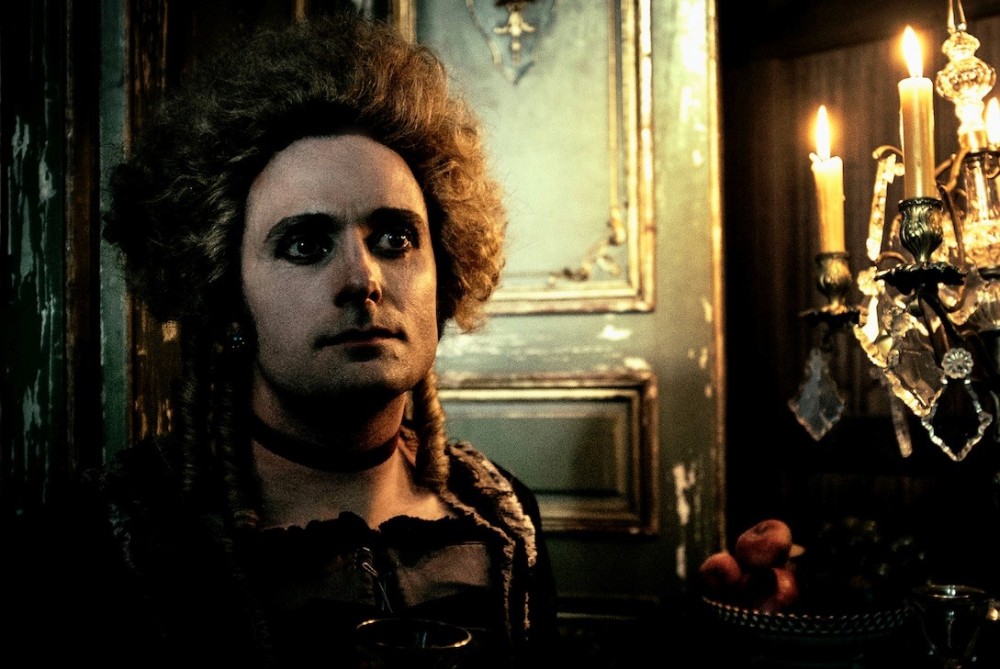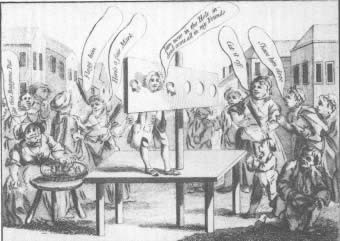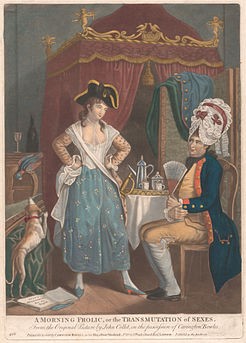Georgian England (1714 to c. 1830–37, named eponymously after kings George I, George II, George III and George IV ) is defined by its tight-laced bodices and breeches, but more importantly by society’s collective dedication to the rules of propriety. Jane Austen has painted the global image of courting ladies and gentleman, of balls heavily regulated by rules, and marriages based largely on equal social standing. Austen’s literature is, perhaps, the most revered among the cultural material of the late 18th century and early 19th century. In consequence, a contemporary audience cannot help but reminisce about a period in history, which—viewed through a lens of her creation—is comprised of dualities: upper class and lower class, or lady and gentleman.
Unsurprisingly, there aren’t many (if any?) instances in 18th-19th century literature where lady and lady or gentleman and gentleman are the focal romantic duality. But we know that history was not strictly heterosexual or cisgender, no matter what the popular fiction might suggest. Since it is, in fact, Pride Month, I’d like to delve into some interesting factoids regarding the gay community and cross-dressing evidenced in English texts from the 1700s. After re-watching BBC One’s Taboo starring Tom Hardy I began to reassess my understanding of Jane Austen’s England. Taboo features incest (still rightly frowned upon today), witchcraft, and political conspiracy. However, of all the taboo subjects examined in the show, what captured my attention was the casual presentation of the LGBT community who were, at the time, confined to covert spaces. Otherwise, they hid in plain sight and passed as same-sex “companions.” At once, I contemplated the hetero romances that comprise many of Jane Austen’s plots and the savory courtships that precede recognized relationships. What a different picture creators Tom Hardy, Edward “Chips” Hardy, and Steven Knight have produced of 18th century England in their BBC show.
In episode three, the sweet-tempered East India clerk, Michael Godfrey (played by Edward Hogg) is exposed as a “molly,” a word which has several possible derivations. In one understanding, the word “molly” is simply a modification of the female name “Mary,” which in itself suggests femininity. The Latin form mollis is an equally effeminate term that labels the passive partner in a homosexual relationship. In the Encyclopedia of Homosexuality, William A. Percy writes:
The Latin mollis may well be the origin of the eighteenth-century English “molly” (or molly-cull) = effeminate homosexual, a term given publicity by police raids on their clandestine haunts in London (1697-1727) following the relative tolerance of the Restoration era that had seen a homosexual subculture emerge in the British metropolis. The term “molly” also suggests the personal name Molly, a variant of Mary, so that the folk etymology introduces a separate nuance of the effeminate 1
 (Michael Godfrey played by Edward Hogg in Taboo, BBC1)
(Michael Godfrey played by Edward Hogg in Taboo, BBC1)
“Molly” was, in fact, a term used pejoratively to refer to lower class women and prostitutes as well. In effect, it is simultaneously an etymological fragment of Georgian England and a derogatory term that admonishes sexual and gender identity. In The London Terrae-filius: or the satyrical reformer. Being drolling reflections on the vices and vanities of both sexes. To be continu’d. By the author of the London-Spy. Numb.V, satirist Edward Ward describes a young man who has been brought up by his mother and has ostensibly been influenced by her delicate nature: “he behaves himself more like a Catamite, an Eunuch, or one of those Ridiculous Imitators of the Female Sex, call’d Mollies, than like a Son of Adam.” 2 This assessment equates manhood with the presence of masculine biological anatomy, ergo eunuchs are ultimately considered sexless. Contemporary society understands gender outside of a binary system and instead places it on a spectrum alongside sexuality. Read Carrie Kilman’s article to understand more about this. In the above assessment, Edward Ward demonstrates the cultural understanding—or lack thereof—regarding identity. The young man he is describing might either be homosexual, sexless, or an imitator of the female sex. In this way, the term “molly” is used broadly to ridicule and demean. In this time, the personal specifics mattered not; for example, a man might cross-dress but that does necessarily mean he’s attracted to men. A propensity for dressing in clothing that is not assigned to one’s gender actually has no relation whatsoever to who one is attracted to or not attracted to. Vern and Bonnie Bullough write more about this in their book Cross Dressing, Sex, and Gender.

(Drawing of a Molly. Margaret Clap [—circa 1726])
Ostracized from society, anyone who did not fit into the preconceived notions of gender gathered covertly as a community in disguised spaces called Molly Houses. William A. Percy writes: “These public houses were at times relatively informal, or there could simply be a special room for ‘mollies’ at the back of an ordinary public house.” 1 In an exposé on the homosexual subculture in early 18th century England entitled: “From a Complete and Humorous Account of All the Remarkable Clubs and Societies in the Cities of London and Westminster,” investigative journalist Ned Ward writes:
There are particular Gang of Sodomitical Wretches in this Town, who call themselves the Mollies, and are so far degenerated from all masculine Deportment, or manly Exercises, that they rather fancy themselves women, imitating all the little Vanities that custom has reconcil’d to the female Sex, affecting to speak, walk, tattle, courtesy, cry, scold, and to mimick all manner of Effeminacy, that ever has fallen within their several Observations; not omitting the Indecencies of lewd Women, that may tempt one another, by such immodest Freedoms, to commit those odious Bestialities, that ought for ever to be without Name. At a certain Tavern in the City, whose sign I shall not mention, because I am unwilling to fix an Odium upon the House, where they have settled a constant Meeting in the Week, that they may have the better Opportunity of drawing unwary Youth into the like Corruption. When they are met together, it is their usual Practice to mimick a female Gossiping, and fall into the impertinent Tittle-Tattle, that a merry Society of good Wives can be subject to, when they have laid aside their Modesty for the delights of the bottle 3
While heterosexual couples were permitted to lie with one another—provided they were married—gay men were forced to seek pleasure in, sometimes quite literally, the dark corners of the city. The legal cost of getting caught in flagrante was considerably high. English newspaper records from 1700-1720 chronicle the multitudinous outcomes for those participating in what the law considered illicit wrongdoing or sodomy. Most men were tried in court and “Whipt from Temple-Bar to Charing-Cross” while others were to “stand in the Pillory at the May-Pole in the Strand, and [be] fin’d 10.” On March 7, 1701, the English Post published an article that illustrates just how deep the fear ran within the homosexual community: “The Parish Clerk of St. Dunstans in the East, being turned out of his Place upon Suspicion of an unnatural Crime &c. Cut his Throat on Wednesday Night almost from Ear to Ear.” 4 For some, suicide was the preferred form of demise.

(A “molly” in a pillory from Political and Personal Satires, vol. 4, pg. 220, 1763, © British Library)
While the men who cross-dressed for personal gratification have been described here, history also consists of women who wore dress considered masculine. In some instances these women cross-dressed to secure a fruitful marriage to a young woman with a dowry. Ann Marrow was convicted at the Quarter Sessions in July 1777 after impersonating a man in order to marry three separate women. Desperate times, call for desperate measures. This case appears to be a matter of pragmatism rather than attraction. Therein lies the disappointing reality that we will never be able to go back in time and ask figures such as Ann Marrow how she identified herself. Her punishment was nonetheless harsh: she was placed in the pillory and pelted at with rocks by bystanders and thereafter lost the sight in both of her eyes. 5 Other instances suggest same-sex attraction. For example, it was discovered that Mary Hamilton participated in sexual acts with a woman before marrying her. In 1764, she was prosecuted and whipped in four market towns and imprisoned for six months. 6

(Male and Female Cross-Dressing, 1780)
While a molly house was an enclosed habitat hidden from the prying noses of the public, some same-sex couples elected to love one another in the view of the whole world. Katherine Bovey and Mary Pope lived together for nearly forty years in what observers called “perfect friendship.” Katherine was just 17 when she met the daughter of John Pope, a Bristol merchant. After Ms. Bovey’s death in 1727, a funeral monument was erected in Westminster and included a rather long inscription crafted by Ms. Pope, which can be read here. Whether or not they did sustain a loyal and long-term romantic relationship is a mystery. Though it is safe to assume there was a valuable sense of intimacy shared between the two women, even if it was only friendship. 7
Admittedly, this post scratches the surface in regards to the wide range of gender identification and sexual preferences. I’ve touched on pansexuality (: of, relating to, or characterized by sexual desire or attraction that is not limited to people of a particular gender identity or sexual orientation). However, sexual orientations like asexuality have no textual evidence in the context of 18th century England because it was simply not a crime to forgo sexual intercourse. Although, there was a different kind of judgement cast upon those who remained unmarried (since marriage was the proper precursor to sex). This shaming applied most prominently to women, who at the time were considered spinsters if they had not exchanged vows by a certain age. I’m sure I’ll talk about spinsterhood in a future post. Men were excluded from the same level of judgement, though undoubtedly wealthy men in need of heirs felt the pressure to find a suitable wife. Confirmed bachelors were those men never bound by matrimonial duties either because they couldn’t find the right woman or were prevented, by law, to find and marry the right man. Or simply they weren’t interested.
For a simple outline on the spectrum of sexual orientations, look through this.
Works Cited:
- Encyclopedia of Homosexuality by William A. Percy
- Oxford Dictionary of National Biography, Edward Ward (1667-1731) by James Sambrook
- The Columbia Anthology of Gay Literature: Readings from Western Antiquity edited by Byrne R.S. Fone
- Early Newspaper Reports (1700-1720)
- Tragic Story of Ann Marrow, 1777
- Myth of the Modern Homosexual: Queer History and the Search for Cultural Unity by Rictor Norton
- Queer City: Gay London from the Romans to the Present Day by Peter Ackroyd
This is so interesting. It’s always something of a shock to me when I read non-Austen stuff about the Georgian period. There seems such a distance between the world of Austen and the world represented in say The Mermaid & Mrs Hancock by Imogen Hermes Gowar or in the TV show Harlots.
But Charlotte Lucas is often read as queer by the way!
LikeLike
I absolutely love Harlots!
It’s really easy to make generalizations about the Georgian Period– that it was all manners and gentility, but people needed an income and things like bawdy houses weren’t exactly hard to come by in the cities.
I think that’s a great reading of Charlotte and somehow I’ve never heard of that. I do know there’s a bisexual reading of Mary Crawford. That especially seems blatant.
LikeLike